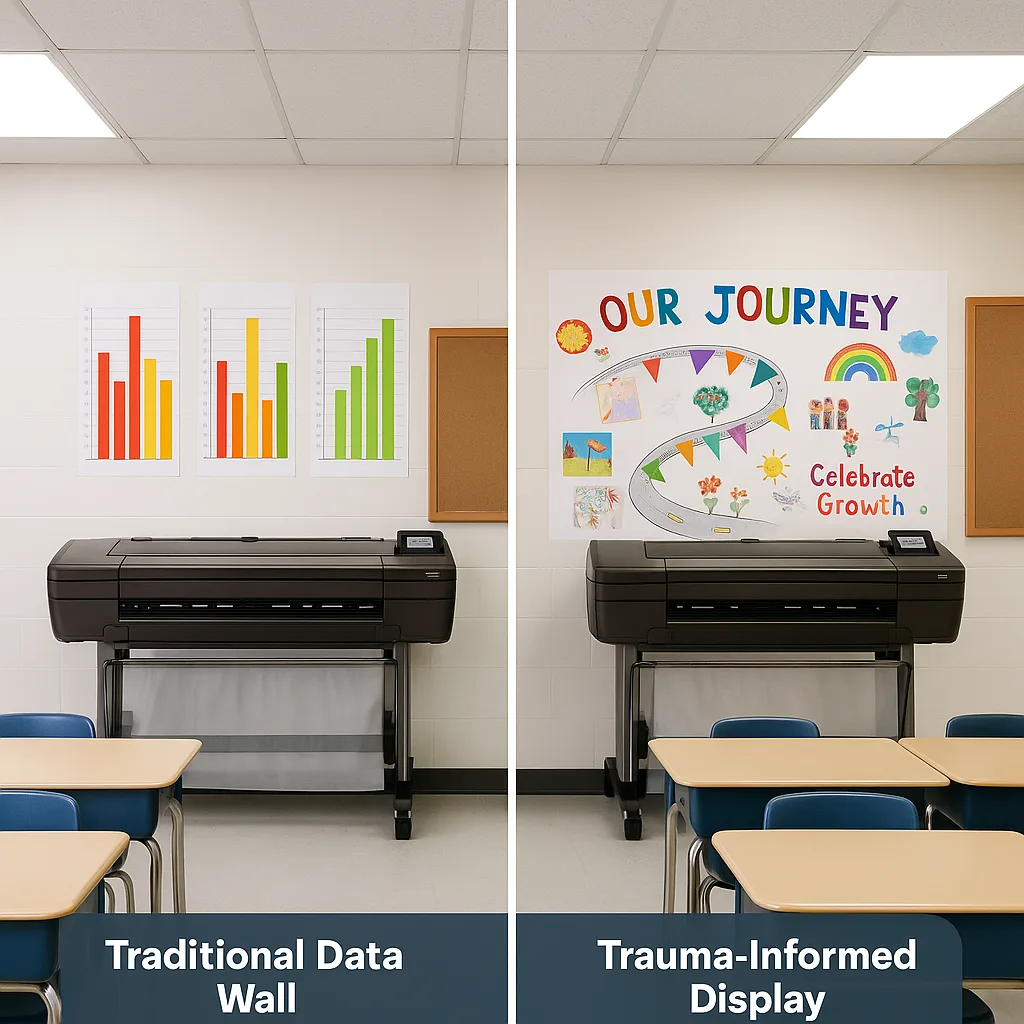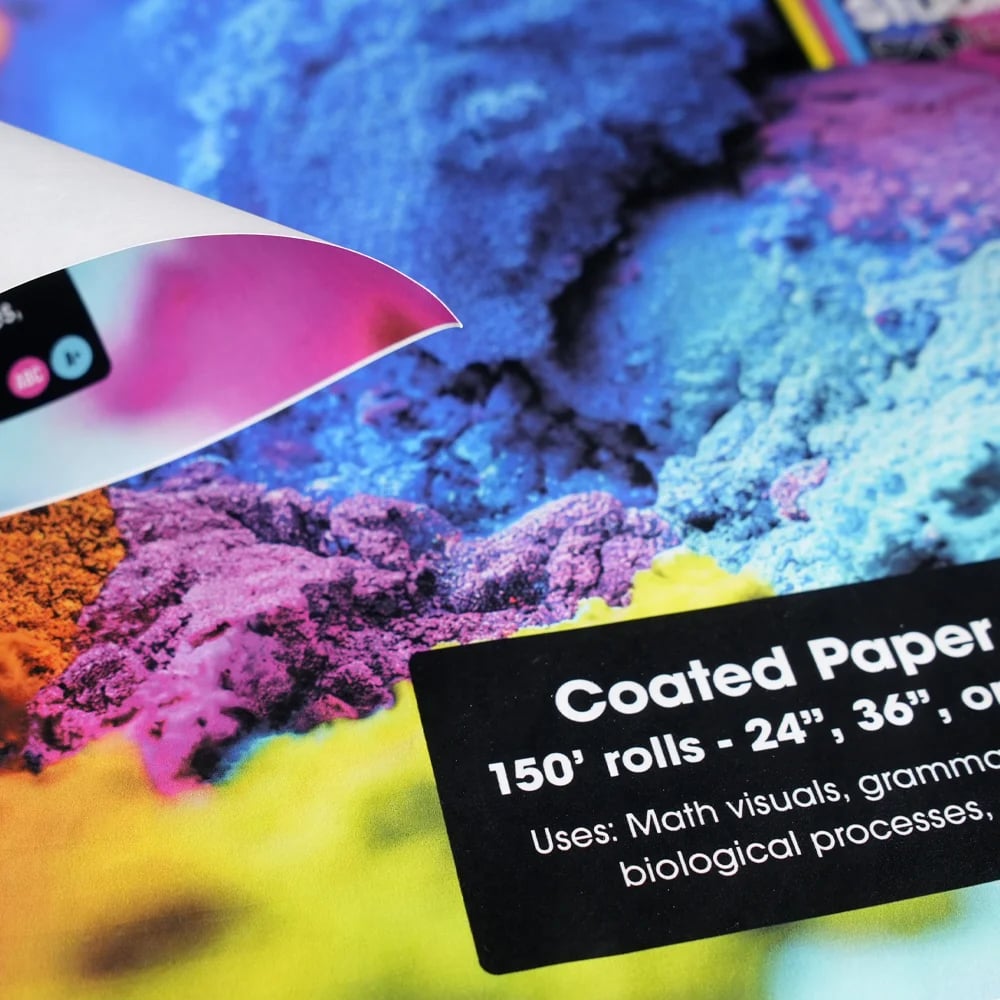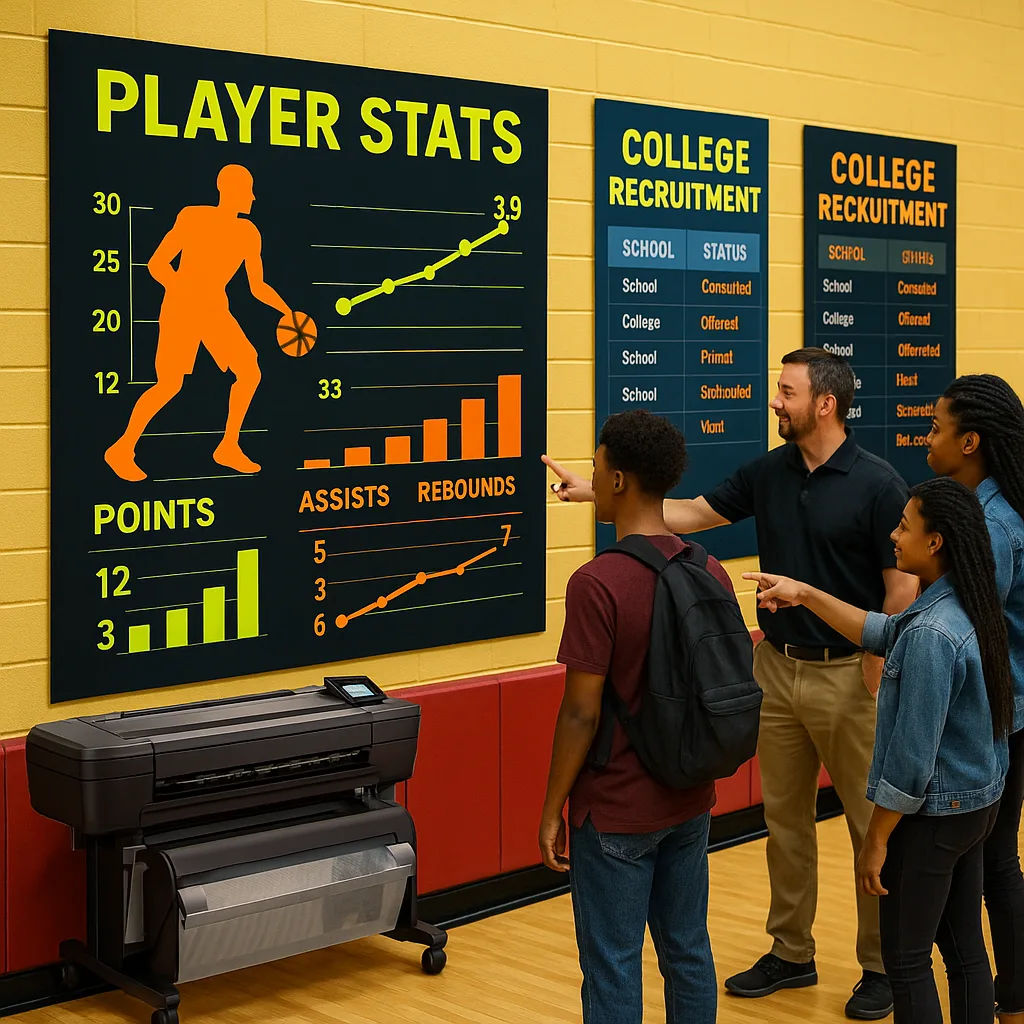
Trauma-Informed Data Displays: Beyond Benchmark Blues
California educators face mounting pressure to display student achievement data while maintaining supportive classroom environments. Therefore, the challenge becomes creating visual accountability systems that motivate rather than mortify. Finding the best poster maker machine for data walls transforms this delicate balance from administrative burden into celebration opportunity.
Traditional Data Walls: When Numbers Become Nightmares
Walk into many California classrooms during benchmark season, and you’ll witness the unintended consequences of well-meaning data display mandates. Furthermore, color-coded charts ranking students from “below basic” to “advanced” create visual hierarchies that can trigger anxiety in vulnerable learners. Consequently, what administrators intend as accountability tools often become sources of shame for struggling students.
Recent research from UCLA’s Center for Mental Health in Schools indicates that public performance displays can activate stress responses in students with trauma histories. Moreover, these traditional approaches often violate fundamental principles of social-emotional learning that California’s Multi-Tiered System of Support (MTSS) framework emphasizes.

Best Poster Maker Machine for Data Walls: Design Principles
Creating trauma-informed data displays requires both pedagogical understanding and practical tools. Subsequently, selecting equipment that enables rapid iteration and customization becomes essential for responsive classroom management.
Core Design Principles:
Calculating True Poster Printer Cost for Data Systems
When districts evaluate poster printer cost for data display systems, initial equipment pricing tells only part of the story. Additionally, consider these comprehensive factors:
Immediate Costs: • Equipment investment: $2,500–$8,000 depending on selected package • Initial media supplies: $300–$500 • Installation/training: Often included with Education Express packages
Ongoing Operational Expenses: • Ink replacement: $150–$300 quarterly with heavy use • Paper/media: $200–$400 per semester • Maintenance: Covered under 5-year warranties
Hidden Savings: • Eliminated outsourcing: $500–$1,500 monthly • Reduced teacher planning time: 10+ hours weekly • Immediate response capability: Priceless during crisis situations
California’s Local Control Funding Formula (LCFF) specifically allows supplemental and concentration grants for materials supporting English learners and low-income students. Therefore, trauma-informed data displays qualify as legitimate expenditures under these funding streams.
Creating Celebration Stations: Practical Implementation
Transform benchmark data from sources of stress into opportunities for celebration through strategic visual design. Subsequently, these approaches honor individual growth while maintaining academic accountability.
Personal Progress Portfolios
Rather than public comparison charts, create individual growth portfolios displayed in student-chosen locations. Furthermore, using weather-resistant materials from the Education Studio series allows outdoor celebration galleries where students feel less confined.
Design elements include: • Timeline graphs showing personal trajectory • Milestone markers celebrating specific achievements • Student-selected evidence of learning • Reflection prompts for metacognitive development
Collaborative Achievement Maps
Replace competitive ranking systems with collaborative visual narratives. Additionally, these displays emphasize collective progress toward shared goals while honoring individual contributions.
Implementation strategies: • Create “journey maps” showing class-wide progress • Use metaphors (mountains climbed, gardens grown) rather than hierarchical levels • Include peer encouragement spaces • Rotate featured achievements weekly
Ready to Transform Your Data Displays?
Start creating trauma-informed celebration stations today. Moreover, our specialists can help design systems that honor every learner’s journey.
Specific Subject Area Applications
Different content areas require unique approaches to trauma-informed data display. Therefore, consider these subject-specific strategies:

Mathematics Progress Create visual number lines showing concept mastery progression rather than test scores

Reading Growth Design “bookshelf” displays where students add titles as they progress through levels

Writing Development Showcase writing samples chronologically to highlight improvement journey
Funding Strategies for Data Display Systems
California schools access multiple funding streams for trauma-informed data display systems. Furthermore, understanding alignment between poster printer cost and available grants maximizes purchasing power.
Primary Funding Sources:
Title I, Part A: Supports academic achievement displays for disadvantaged students. Additionally, trauma-informed approaches directly address achievement gaps through improved social-emotional support.
LCFF Supplemental/Concentration Grants: California’s funding formula specifically targets English learners, foster youth, and low-income students—populations most affected by trauma. Therefore, data display systems supporting these groups qualify for enhanced funding.
Mental Health Services Act (MHSA) Prevention Funds: Several California counties allocate MHSA dollars for school-based prevention programs. Subsequently, trauma-informed visual systems supporting student well-being may qualify.
21st Century Community Learning Centers: After-school programs receiving these federal funds can purchase display systems for student progress tracking and family engagement.
Implementation Timeline: From Blueprint to Celebration
Transitioning from traditional data walls to trauma-informed celebration stations requires systematic planning. Therefore, this phased approach ensures sustainable implementation:
Assessment Phase: Survey students about current data display feelings. Additionally, document existing display locations and student traffic patterns.
Design Phase: Collaborate with students to create prototype displays. Furthermore, test different visual metaphors for progress representation.
Pilot Phase: Implement new displays in one subject area first. Subsequently, gather feedback and refine approaches before school-wide rollout.
Full Implementation: Expand successful models across all content areas. Moreover, establish regular celebration cycles and student reflection opportunities.
Best Poster Maker Machine for Data Walls: Equipment Selection
Choosing appropriate equipment significantly impacts implementation success. Furthermore, California’s diverse climate and classroom configurations require versatile solutions.
Essential Features for Trauma-Informed Displays: • Quick production capability for responsive adjustments • Weather-resistant options for outdoor celebration spaces • Multiple size formats accommodating different privacy needs • High-resolution output ensuring professional appearance • Cost-effective operation enabling frequent updates
The Education Flex series offers print-and-cut functionality ideal for creating custom shapes that soften data presentation. Additionally, these systems produce window clings allowing students to control display placement.
For larger implementations, consider the Education Studio 44″ which creates gallery-sized celebration walls. Subsequently, entire grade levels can showcase collective achievements without individual comparisons.
Budget-Conscious
Versatility-Focused
Innovation-Ready
Privacy Considerations and Ethical Guidelines
California Education Code Section 49073.6 requires parental consent for certain student information displays. Therefore, trauma-informed data walls must balance transparency with privacy protection.
Legal Compliance Strategies: • Use student-selected pseudonyms or symbols • Display progress without identifying information • Create opt-in celebration opportunities • Maintain separate private tracking systems
Ethical Considerations Beyond Compliance: • Honor student autonomy in display participation • Provide multiple representation options • Regularly revisit consent with students • Document display preferences in IEPs/504 plans
The Lifetime Design Service helps create FERPA-compliant templates. Additionally, their human designers understand educational privacy requirements better than AI-generated alternatives.
Transform Your Assessment Culture Today
California educators deserve support creating celebration-focused assessment environments. Furthermore, proper equipment and design guidance make transformation achievable within existing budgets.
Professional Development: Building Trauma-Informed Display Skills
Successful implementation requires comprehensive staff development beyond equipment operation. Therefore, districts should allocate professional development hours for trauma-informed design principles.
Essential Training Components:
Trauma-Responsive Design Theory (4 hours) • Understanding stress responses to public displays • Recognizing cultural considerations in data representation • Identifying triggers in traditional achievement charts • Developing alternative visual metaphors
Technical Skills Development (2 hours) • Operating poster production equipment • Using design software effectively • Creating accessible visual layouts • Maintaining consistent brand standards
Collaborative Planning Sessions (3 hours) • Aligning displays with SEL competencies • Coordinating cross-curricular celebrations • Establishing rotation schedules • Planning family engagement events
Ongoing Reflection Cycles (Monthly) • Analyzing student feedback data • Adjusting displays based on needs • Sharing successful strategies • Troubleshooting challenges collaboratively
Measuring Impact: Beyond Test Scores
Evaluating trauma-informed data displays requires holistic assessment approaches. Furthermore, traditional metrics alone cannot capture social-emotional improvements.
Quantitative Indicators: • Attendance rates in data-display classrooms • Student self-referrals for academic support • Parent engagement at data conferences • Time-on-task during independent work
Qualitative Measures: • Student interviews about classroom comfort • Teacher observations of peer interactions • Family feedback on home conversations • Counselor reports on anxiety levels
Research from Stanford’s Challenge Success program demonstrates that reducing performance anxiety correlates with improved long-term achievement. Therefore, investing in trauma-informed displays supports both immediate well-being and future success.
Conclusion: From Compliance to Celebration
California’s education system stands at a crossroads between data-driven accountability and trauma-informed practice. Furthermore, selecting the best poster maker machine for data walls enables educators to honor both mandates simultaneously. Through thoughtful design, strategic equipment investment, and commitment to student well-being, benchmark blues transform into celebration stations.
The journey from traditional data walls to trauma-informed displays requires courage, creativity, and proper tools. Additionally, districts investing in comprehensive poster production systems find unexpected benefits beyond compliance—increased family engagement, improved classroom climate, and students who view assessment as opportunity rather than threat.
Contact Poster Studio Express at 866-788-7900 to explore how your district can implement trauma-informed data displays. Moreover, their education specialists understand California’s unique requirements and can recommend systems aligning with your budget, space, and student needs. Because every student deserves to see their growth celebrated, not their struggles spotlighted.







